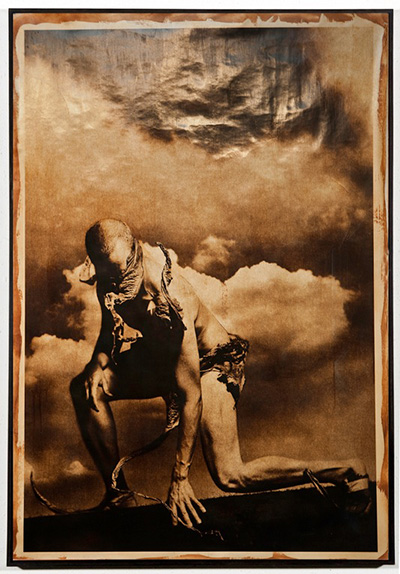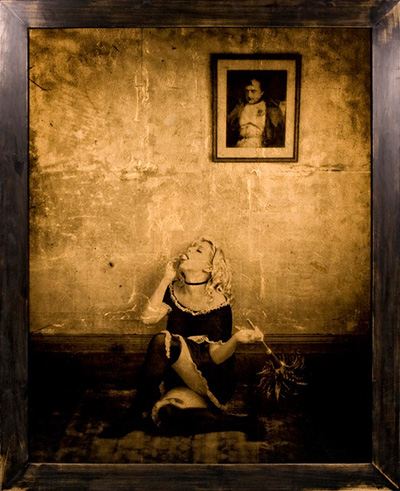Louviere+Vanessa
March 2013 –  The camera has often been described as a sort of mechanical extension of the artist’s body. Or, as critic Paul Rosenfeld once described it, “a machine in perfect obedience to the human spirit.”[1] Sharing this sentiment in 1902, the legendary photographer Alfred Stieglitz formed a movement he called Photo-Secession, which reevaluated photography not by the subject, but by how the individual artist manipulated the image according to his/her subjective visions. These were early steps in the progression that defined photography as an essential link between art, invention, and the human psyche. Throughout the 20th century, and into the 21st, photography has experienced steady and relatively rapid growth as a serious art form. Because of its late recognition as an art form, as compared to painting or sculpture, and its wide accessibility as a mechanical, and nowadays digital, process, some may prescribe photography as a ‘safer’ art, both in terms of production and interpretation. But photography, by its very nature, has occurred completely out of artists’ ingenious and technical sensibilities, and as such, is the only art form that is completely open to a vast range of experimentation.
The camera has often been described as a sort of mechanical extension of the artist’s body. Or, as critic Paul Rosenfeld once described it, “a machine in perfect obedience to the human spirit.”[1] Sharing this sentiment in 1902, the legendary photographer Alfred Stieglitz formed a movement he called Photo-Secession, which reevaluated photography not by the subject, but by how the individual artist manipulated the image according to his/her subjective visions. These were early steps in the progression that defined photography as an essential link between art, invention, and the human psyche. Throughout the 20th century, and into the 21st, photography has experienced steady and relatively rapid growth as a serious art form. Because of its late recognition as an art form, as compared to painting or sculpture, and its wide accessibility as a mechanical, and nowadays digital, process, some may prescribe photography as a ‘safer’ art, both in terms of production and interpretation. But photography, by its very nature, has occurred completely out of artists’ ingenious and technical sensibilities, and as such, is the only art form that is completely open to a vast range of experimentation.
 The New Orleans-based duo of Jeff Louviere and Vanessa Brown are photographers by means of their affection for the medium and their penchant for being so scientifically creative. They succeed in reintroducing photography. Known dually as Louviere+Vanessa, these artists employ experimental techniques that recall a more intimate and less synthetic past. Their daring burst beyond the current zeitgeist of digitization shakes us from the complacency of a crisp reality and invites us back into a more intriguing and softer side of a dream, often relief and sometimes horror. Amid an age where pixels construct our windows out to the world, Louviere+Vanessa want to revisit that exploratory and surreal look inward toward a dream-state originally penetrated by those innovative photographers from the early 20th century. Artists like Man Ray, Henri Cartier-Bresson, Eugéne Atget, André Kertész, and George Brassaї took on photography as a mechanical means of analyzing reality and often emphasized the importance of what Cartier-Bresson called the image á la sauvette (the decisive moment). They used their cameras to not merely capture reality, but to freeze it, allowing us ample time to mentally digest it and question its clarity.
The New Orleans-based duo of Jeff Louviere and Vanessa Brown are photographers by means of their affection for the medium and their penchant for being so scientifically creative. They succeed in reintroducing photography. Known dually as Louviere+Vanessa, these artists employ experimental techniques that recall a more intimate and less synthetic past. Their daring burst beyond the current zeitgeist of digitization shakes us from the complacency of a crisp reality and invites us back into a more intriguing and softer side of a dream, often relief and sometimes horror. Amid an age where pixels construct our windows out to the world, Louviere+Vanessa want to revisit that exploratory and surreal look inward toward a dream-state originally penetrated by those innovative photographers from the early 20th century. Artists like Man Ray, Henri Cartier-Bresson, Eugéne Atget, André Kertész, and George Brassaї took on photography as a mechanical means of analyzing reality and often emphasized the importance of what Cartier-Bresson called the image á la sauvette (the decisive moment). They used their cameras to not merely capture reality, but to freeze it, allowing us ample time to mentally digest it and question its clarity.
Louviere+Vanessa continue this tradition, but elegantly apply a cloudier veneer of ambiguity. Their photographs, with a heightened sense of romantic mystery and unclear iconography, are intended to present a more fluid state of reality. In this way, they are reminiscent of early Symbolist photographers who prized “. . . introspection rather than observation [and] advocated a withdrawal into the life of the imagination and gave primacy to the irrational, the unconscious, and the dream.”[2] Symbolists helmed an experimental take on the then still evolving photographic process. Similarly, the Surrealists of the mid-20th century explored the boundaries of reality through photography and reinterpreted the camera as a tool to reach the unconscious. Early endeavors by these photographers seem to now have a direct influence on Louviere+Vanessa’s fascination with taking advantage of photography’s ability to reproduce reality and use it to ironically discover a renewed surrealism.
 As physical components of their segues into alternative realities, Louviere+Vanessa experiment with an array of diverse materials in their numerous series of works. Ingredients such as gold leaf, Super 8mm film, distressed photographic negatives, wax, and even blood are introduced into their photographic methods. These materials are explored and manipulated by the artists to yield new and exciting effects that push the boundaries of image-making. Simultaneously, Louviere+Vanessa force us to seriously reconsider what we may take for granted and reevaluate what we may perceive as being a safe art form. By breaking with tradition, this duo contributes to the contemporary resurrection of traditional photography, expands the vulgate of photographic history, and allows us to dispense with typical philosophies.
As physical components of their segues into alternative realities, Louviere+Vanessa experiment with an array of diverse materials in their numerous series of works. Ingredients such as gold leaf, Super 8mm film, distressed photographic negatives, wax, and even blood are introduced into their photographic methods. These materials are explored and manipulated by the artists to yield new and exciting effects that push the boundaries of image-making. Simultaneously, Louviere+Vanessa force us to seriously reconsider what we may take for granted and reevaluate what we may perceive as being a safe art form. By breaking with tradition, this duo contributes to the contemporary resurrection of traditional photography, expands the vulgate of photographic history, and allows us to dispense with typical philosophies.
Coincidence, currently on view at Polk Museum of Art until April 20, is a survey of seven respective bodies of work produced by Louviere+Vanessa. It is a testament to where they have arrived after their first decade of collaboration. Since their first professional exhibition in 2004, Louviere+Vanessa have participated in over 50 exhibitions and film festivals nationally and internationally. Last year they were included in the Ballarat International Foto Biennale in Australia. Jeff Louviere graduated from the Savannah College of Art and Design. Vanessa Brown graduated from Rochester Institute of Technology.
 Adam Justice
Adam Justice
Curator, Polk Museum of Art
[1] Neil Baldwin, Man Ray: American Artist. Da Capo Press, Inc., New York, 1988.
[2] Pierre Apraxine, “Turn of the Century: Chrysalis of the Modern,” from The Waking Dream: Photography’s First Century. The Metropolitan Museum of Art: New York, 1993.


{Socialize}